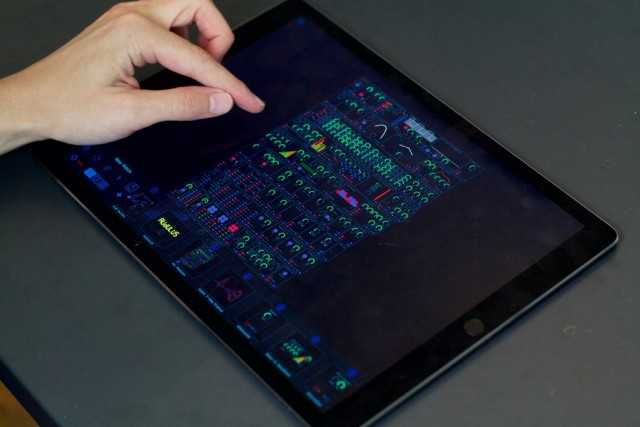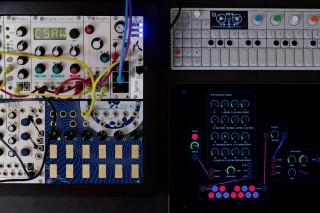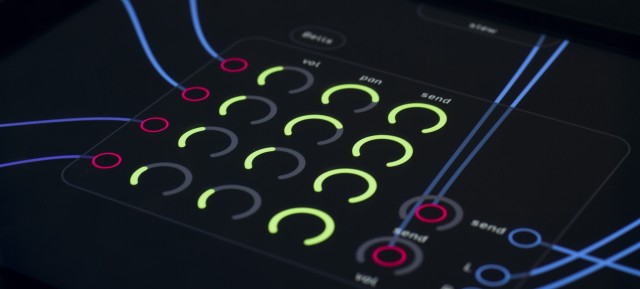
Earlier this month, developer Taylor Holliday released Audulus 3 – a major update to his modular audio app for iOS, Mac & Windows.
Now that Audulus 3 is available, Holliday had time to answer some questions about his background, the new Audulus release, his thoughts on the iPad Pro and more.
Synthtopia: For readers that may not be familiar with Audulus yet, give us your ‘elevator pitch’ summary of what it is and why electronic musicians should check it out…..

Taylor Holliday: Audulus is a visual programming language for sound, built for the future. I’m not just trying to build another modular app, but rather one that is very general-purpose, technologically superior, and beautiful.
Audulus allows you to build a modular synth module that actually works like a hardware module with I/O wherever you want it.
Audulus does that in an infinite canvas—inspired by 3-D animation software—with extremely smooth graphics. The visual feedback in Audulus is second to none: every wire lights up according to the amplitude of sound or CV within. And just like a hardware modular, modules aren’t reset when you make a connection. But Audulus goes beyond a hardware modular by fading in and out individual connections, with virtually zero performance overhead, for live patching without pops.
These features, along with an attention to visual design, and great-sounding modules like the new oscillator in Audulus 3, make Audulus an exciting and engaging audio processing environment.
Synthtopia: Taylor – what’s your personal background and how did you get into developing music software?
Taylor Holliday: My technical background is in computer graphics software development. Before Audulus, I worked at Pixar Animation Studios, where I contributed to their in-house animation software.
Musically, I’m primarily a guitarist, and I’ve played recreationally in rock bands. But these days, I’m hoping to do live modular stuff with Audulus. Now that version 3 is out, I should have time to do that.
I actually began developing music software because Pixar wouldn’t let me work on graphics software in my spare time. So, with the blessing of Pixar’s legal department, I began writing a replacement for my guitar pedalboard. I then developed an interest in synthesizers, and the app morphed into more of a synth.
In 2012, I decided to try Audulus full-time, which was incredibly scary at first, but has worked out well.
Synthtopia: What are the key new features in Audulus 3 that you think people should be aware of?
Taylor Holliday: The biggest new feature is the new library of modules that comes with Audulus, created by our new evangelist, Mark Boyd.
His modules are a step up in complexity from nodes, and they offer the user a Eurorack-level of patching. Along with all the modules we’ve also got a great new UI for adding them to your patch.
We also have a new tutorials series that comes with Audulus 3. Mark took his knowledge of Audulus and his familiarity with the forum to write three excellent tutorials that address concepts he felt new users were struggling to understand. He also has some more advanced tutorials in the works – I’m really excited to see what his Cartesian Sequencer tutorial turns out like!
And of course there are huge UI enhancements. With a rewritten core, the app is extremely quick at loading large patches.
Synthtopia: What platforms is Audulus 3 going to be available for? And can you share anything about the distribution of users across your various platforms ?
Taylor Holliday: Audulus 3 is available for Mac and iOS, with Windows coming along soon.
About two thirds of Audulus users are on iOS. There’s a lot of excitement and a great community for iOS music makers.
Synthtopia: I noticed you shared a demo of Audulus 3 running on an iPad Pro (embedded below):
What do you think of the iPad Pro as a platform for Audulus? Do you have any thoughts on the prospects for music software on it?
Taylor Holliday: I LOVE the iPad Pro hardware and it’s a great platform for Audulus. The extra room feels really nice. Music software on iOS could become ever more compelling because of iPad Pro.
However, Apple may have hobbled the iPad Pro. To make pro apps a sustainable business on iOS, developers need to be able to offer discounted upgrades, a feature Apple currently does not allow for in the App Store.
Developers also need a way to do trial versions (they are currently prohibited by Apple).
For apps like Audulus, we need these kind of features in the App Store. On the Mac side, we’ve already seen influential developers leave the Mac App Store, in part because Apple doesn’t have these features.
Synthtopia: What does Audulus’s multi-platform support mean for users – both in terms of buying it and workflow?
Taylor Holliday: I’m often asked if there’s a multi-platform bundle. Unfortunately, Apple doesn’t offer bundles between iOS and Mac apps. I’m hoping they will at some point. Offering a single license for desktop apps (Mac/Windows) would require us offering a version outside the Mac App Store, which we are considering.
In terms of workflow, the iOS and Mac apps can sync patches using iCloud. It’s really cool, and Apple has ironed out the problems users may have encountered before.
Synthtopia: In one of your preview videos, you mentioned that you are getting rid of the Audulus store. What’s the reason for that – and what does this mean for existing users?
Taylor Holliday: I decided to remove the store because I didn’t like having to spend time deciding what should and shouldn’t be an IAP (in-app purchase), and I didn’t particularly enjoy building a store.
I’m in this to build an awesome app and have fun doing so, not to spend time writing and debugging a store. And I’ve come to think that serious apps generally shouldn’t have IAPs, or the IAPs should be for additional content, not to unlock features.
 Synthtopia: You’ve previously shared a video demonstrating Audulus being used with a Euroack system.
Synthtopia: You’ve previously shared a video demonstrating Audulus being used with a Euroack system.
If readers are interested in integrating Audulus with a hardware modular, what would you recommend?
Taylor Holliday: The easiest way is still forthcoming: MIDI output modules in Audulus.
However, if you have a DC-coupled audio interface, you can send signals directly from Audulus to the interface. We’re going to be working on demos of how to do that, now that Audulus 3 is out.
Synthtopia: Speaking of hardware – at one point, you speculated about the possibility of using Audulus to create patches that would run on DSP hardware devices, like the OWL. Do you have any plans along those lines?
Taylor Holliday: I looked into that a while ago. It’s quite interesting, but it would put some constraints on what one can do inside Audulus, since the hardware has limitations when compared to a full computer. We’re going to be looking into that more in the future.
Audulus could try its best to run a particular patch on a separate device, and let the user know if it isn’t possible.
Synthtopia: Is there anything else that you’d like to share with readers?
Taylor Holliday: It’s been quite an awesome journey getting to Audulus 3, and I’d like to thank the many Audulus users that have made this possible!
Synthtopia: Thanks for taking the time to answer our questions, Taylor.
Taylor Holliday: Thanks, Synthtopia!
You can find out more about Audulus at the Audulus site.




i’ve been having fun making noises in audulus on ipad. we’ve heard a lot about midi out coming soon, but will midi IN be fixed? currently the software treats all incoming midi as one channel on one port. being unable to parse by channel and/or port makes integrating it with more than just a single keyboard or companion app fairly impossible. in it’s current state audulus is a great stand-alone app, hopefully future versions will add the necessary functionality to use it in a multi app and controller setup.
Hey mellonhead, I’ll be upgrading the MIDI functionality cheers -Taylor
cheers -Taylor
+1 for comprehensive MIDI support.
I’d also love to be able to integrate it with my modular using CV
“Taylor Holliday: I decided to remove the store because I didn’t like having to spend time deciding what should and shouldn’t be an IAP (in-app purchase), and I didn’t particularly enjoy building a store.
I’m in this to build an awesome app and have fun doing so, not to spend time writing and debugging a store. And I’ve come to think that serious apps generally shouldn’t have IAPs, or the IAPs should be for additional content, not to unlock features.”
This man said so many true words!
User Alexander cloned Pong into Audulus 3. Check forum.audulus.com for more details. I will be ramping up output of educational materials once I get back from break. Here’s my contribution to the weird science of Audulus: CRT TV and the Binary Gear with Interlacing (data compression and decompression) https://m.youtube.com/watch?v=3cMeGZRFIjU and heres an XY controller I hacked into Audulus in less than an hour: https://m.youtube.com/watch?v=qyyFEBn0TXs
If Audulus is lacking a feature you want, perhaps you can make it yourself with the ingredients provided!
Get Audulus today and come meet us over at the forum.audulus.com ! Our user base is half the reason this program rocks so much – I was hired out of the forum during version 2 for creating this: http://www.matrixsynth.com/2015/01/cogito-cartesian-sequencer-for-audulus.html
“technologically superior” – thats a mouth full of words
where are the zdf filters, the convolution things, the diode clippers that don’t sound like bs?
Hi Max,
Coming from a computer science perspective: Convolution, zdf filters, diode clippers are all things that I’d like to be realized in Audulus as patches, rather than building them into Audulus as nodes. We already have the ability to do single-sample computation that’s required to do zdf (and many other filters). One issue is that on iOS, due to Apple’s security restrictions, we can’t generate machine code, so there are performance issues (I’m going to mitigate this by isolating the single-sample feedback portions of the graph, but it makes scheduling more tricky). On Mac and Windows though we’re going to have comparable speed to C via LLVM, which is going to be awesome.
All in time
cheers
– Taylor
thx for taking the time to answer
longer thinking about superior technology …
tuning a=non 440z
and support for microtuning (import of .scl and .tun)
I meant to write non 440 hz
Nice to see Taylor and Adulus getting some attention. It’s one of the most innovative music apps I’ve seen in a long time and makes great use of the capabilities of iPads. I’d love to try it on an iPad Pro, but I’m going to hold off and see how the Pro takes off with music app developers.
Audulus is a great modular app and the support by Taylor and Mark is excellent. They are actively listening to the the feedback from their users and working hard to meet our needs. Looking forward to how Audulus will evolve over the coming year especially with the addition of LINK and a more robust MIDI implementation.
I bought the old version of Audulus.
Contact me mark@audulus.com and we’ll get you straightened out
While i’m fan of Chris Wolf’s Jasuto, i respect and like what Taylor does with Audulus. Thanks for keeping it alive and developing it further, and good luck! And thanks for interview, was interesting to learn about Taylor’s background.